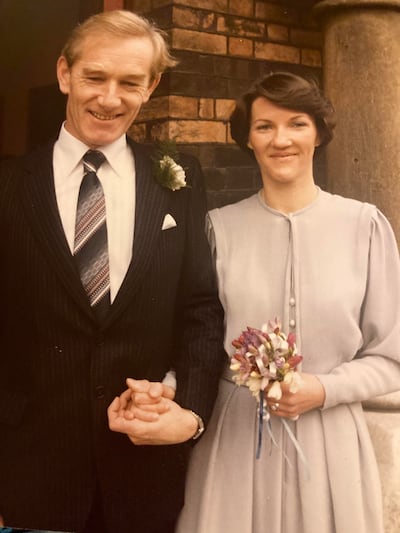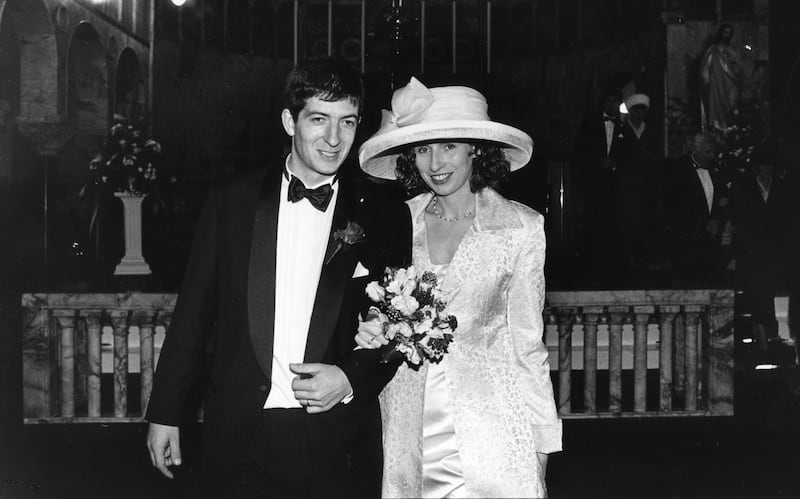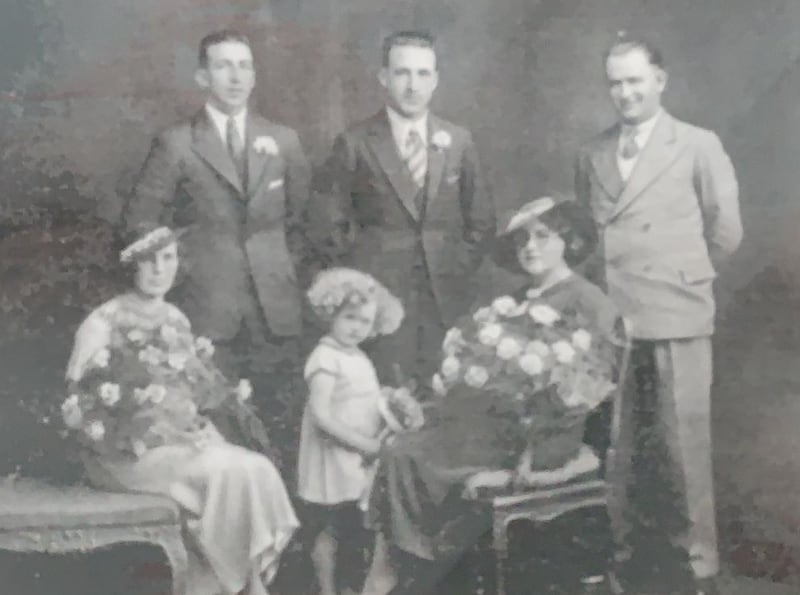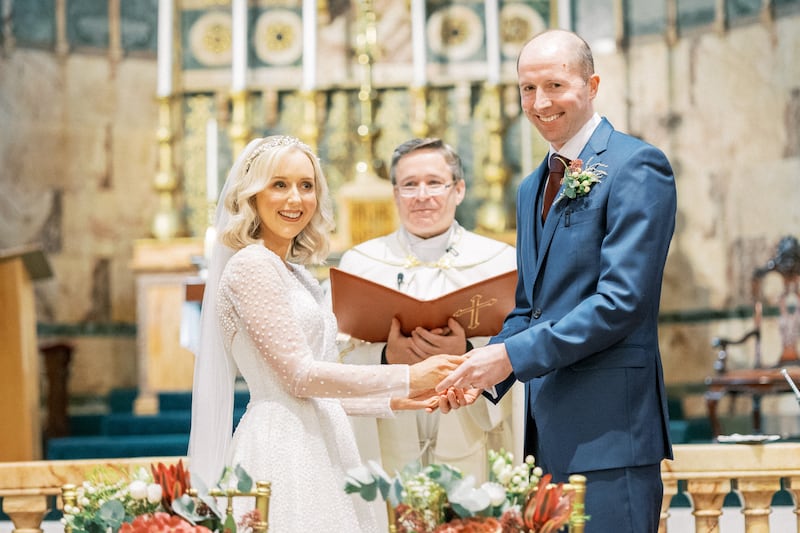Two weeks before their wedding date, Patrick and Eileen Milne were told the priest due to marry them had died suddenly on a golf course. Some might see that as a bad omen for the soon-to-be newlyweds but, more than 57 years later, they’re as strong as ever.
It was the summer of 1965, and the Dublin natives wed at their local parish church off St Stephen’s Green, Newman University Church. Although it appears quaint to passersby with its nondescript entrance, the 19th-century church has been home to weddings for generations of Dubliners.
“We never lost the faith, that was one thing,” says 80-year-old Eileen. “And probably that’s what kept us together, maybe, I don’t know… No one else would have us!”
Few in their collection of wedding photos are still alive. Photography inside the church was restricted back then, so the Milnes have only a couple of photographs to remember the day by. One shows the simply-dressed bride and groom leaving the church flanked on either side by Eileen’s fellow musicians in the Emerald Girls Pipe Band, all dressed in deep green hats, coats and chequered skirts.
READ MORE
“You didn’t have the hundreds at weddings they have nowadays,” Eileen recalls. “You see in those days you would have close friends and relations. You wouldn’t have been able to afford 200 or 300 one way or another.”
Time has passed drastically for the church too. The ceremony took place pre-Vatican II when Mass was in Latin, the priest turned away from parishioners and the only time a woman was allowed on to the altar was on her wedding day.
“Religion to me is God, not the trappings around it and the institution. A lot of things have happened in the church and people condemning it – and rightly so. I don’t dwell too much on it because at the end of the day it’s God that will judge us all, I suppose. That’s my religion anyway.”
The couple, now in their 80s, sent in photographs for a new project in Newman University Church which has collected wedding photos from as far back as 1936 for a Valentine’s Day exhibition. The exhibition will be launched after 6:15pm Mass on Sunday, where parishioners will share champagne and chocolate in the run-up to Valentine’s Day. An online edition of the album will also been launched, showcasing happy couples from across the country.
Founded in 1856 by St John Henry Newman, who established what is now University College Dublin (UCD), the church is unlike many others in Dublin. Its Byzantine-revival style lends a unique look for a church in the middle of Dublin.
In 2016, the University of Notre Dame began its stewardship of the church on behalf of the Archdiocese of Dublin. After frequently hearing stories from visitors of relatives getting married at the church, the team set out to collect photographs old and new.
Felicity and Cyril O’Halloran: ‘It was meant to be’
Another couple who married at the church were Felicity and Cyril O’Halloran, who tied the knot in 1979.
The pair met nine years before that, at Baggot Street Hospital, where Felicity worked as a nurse in the A&E department. Cyril stumbled in one day after a boiler tank fell and crushed his hand.
“It was meant to be,” their son John says, laughing.
Cyril returned to the hospital on several occasions for treatment, eventually mustering up the courage to ask his crush to the races. From then on, he lovingly nicknamed her his “nurse”.
Newman University Church was where they attended Mass on Sundays, often followed by a stroll around the park and some lounging on deck chairs for the afternoon. There was no better place to go for the big day.
“The sun was shining on the 29th of December, believe it or not,” Felicity remembers fondly of her wedding day.
Although the O’Hallorans had no wedding photographer booked, a couple who got married in the church an hour before offered to lend them their snapper for some photos on the green.
“It was just so kind,” Felicity says. “I would love to know who [they were] and thank them.”

Felicity still cherishes her first portrait with her groom, she holding a small bouquet in one hand and her husband’s hand in the other.
Cyril fell ill and passed away two years ago.
“Mom looked after him very well,” says John. “Right up to the end he said: ‘You’ve always been my nurse.’”
When Felicity went to visit him at his nursing home in Harold’s Cross, he’d quip, “Oh, here’s my nurse.” To which she’d reply, “Don’t be codding me now, I know who your favourite nurse is.”
The team would play Cyril’s classical music for him. “They were absolutely wonderful,” Felicity says, “we were so lucky.”
“He was just such a gentle man. He couldn’t cook,” she laughs. “He had a little dog that everybody loved and used to take for a walk every day.”
Theirs was a love born of a different time in a different church where much remains unrecognisable today, but over the years little has changed about cupid’s arrow and the love that ensues.
Fiona O’Flynn and Andrew Robertson: ‘Love is the one constant’
She went to UCD, he went to Trinity: it’s a meet cute we’ve all seen before. Fiona O’Flynn and Andrew Robertson met through mutual friends while at college in the mid-1990s.
After dating for a few years, the pair decided to move in together – much to the disapproval of their traditional mothers.
“Our mothers particularly both took a stand,” says Fiona. “They had a very definite idea about living together before you get married.”
They even restricted communications for a while, only dropping things at the doors of their houses, such were their convictions.

“Pretty much the week before we were due to move into the house,” Andrew says, “I went down on one knee to make sure everything was kosher and the parents were delighted as a result – it was romantic but it was also quite practical.”
Their church of choice was attached to Fiona’s old school, Loreto College off St Stephen’s Green; the same church where her grandparents married in 1936.

“We liked the idea that it was on Stephen’s Green – real hustle and bustle – and then we stepped inside and it was quite small, quite cosy, very serene in the middle of town,” Andrew explains.
Despite their January wedding landing on “an absolutely miserable day”, Andrew feels their wedding day was “the one day where you really feel everyone’s on your side”.
Since then, the same priest has baptised their three children and buried their two mothers. But although more than 25 years have passed since their big day in 1998 (they are now in their 50s), “love is still the same”, says Andrew.
“It hasn’t really changed that much at all despite everything that’s changed around it,” he says. “It’s the one constant bit.”
Social media and dating apps have complicated the love game, but the next generation are “not given the credit they deserve”, he says. “They’re actually quite robust [and] together.”
What’s their secret to long-lasting love? After a pause for a few seconds too long, Andrew jokes: “Silence.”
“We bring out the best in each other,” he says. “We’ve always been best friends and I think that’s been the basis of everything through kids, through family, through ups and downs. It’s just to trust each other and bring out the best in each other.”
David McGrath and Niamh Ryan: ‘One out of two ain’t bad’

During the first wave of the pandemic, David McGrath would pop into church every day and pray for two things: the woman of his dreams and for Glasgow Celtic to win 10 successive football titles in a row.
“One out of two ain’t too bad, you know,” he says now, on a call with his wife, Niamh Ryan.
“I still think he would have preferred two out of two,” she jokes in response.
The pair met for a coffee date in St Stephen’s Green in June 2020 after matching on Tinder – or the “modern dancehall”, as David calls it – and things moved swiftly thereafter.
After 20 months of dating, Niamh brought her boyfriend to Paris for his 40th birthday. Brushing against him on the Métro, she felt a small box in his jacket pocket.
“Surely he wouldn’t propose in Paris?” she thought to herself. “Booking the trip, I’ve set it up for him.”
Two days later, on the eve of Valentine’s Day, he got down on one knee in the Louvre Museum and popped the question. By November they were walking down the aisle of Newman University Church, arm in arm, as a married couple.
They took photos on the green and held their reception at a venue in The Irish Times’s former offices on Fleet Street.
“We’re early out in our journey so we can’t profess to know to know as much as someone married since ‘65, but communication [is important],” David says.
For Niamh, it’s all about compromise: “You have to get used to other people’s ways and find that nice balance or compromise. You have to keep the door open for communication… If you don’t share with someone, they’re not going to understand.”
The bricks and mortar making up Newman University Church have changed hands many times over. The community has evolved and so too has the doctrine preached within. But in these stories, it’s clear that despite all this, the love celebrated is far from changing.
The exhibition will run in the church atrium until March 19th and the online collection will be updated regularly. To submit your wedding photos, visit newman.nd.edu










